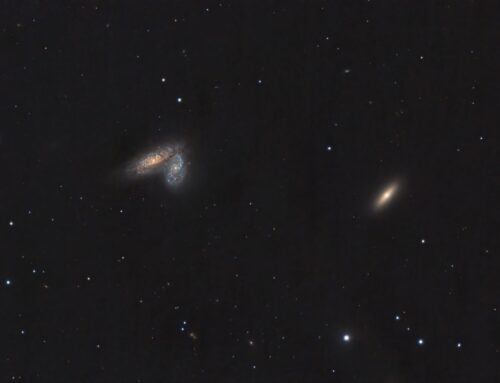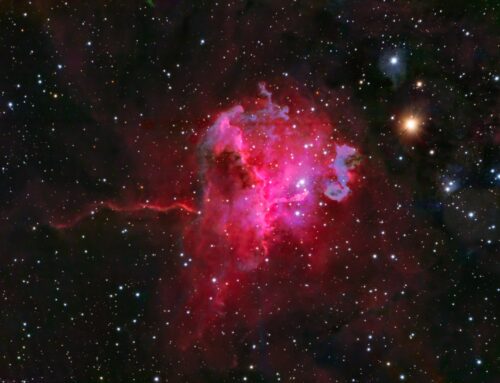NGC2420 Open Cluster
 Click image for full size version
Click image for full size version
March 21, 2016
NGC2420 is an open cluster located in Gemini. It is usually overlooked because there are other, richer open clusters nearby, for example M35 and NGC2158. NGC2420 contains about 1,000 stars packed into an area with a diameter of about 30 light years. It lies about 7,000 light years from using the Perseus arm of the Milky Way Galaxy. If you look closely, you will also find many galaxies around this image, which is surprising given how bright the Moon was during this imaging session. A nice example of an edge-on spiral galaxy lies above the cluster, halfway to the top edge. There’s a pair of galaxies to the lower right of NGC2420, in the 5-o’clock direction. All the galaxies in this image are far, far in the distance. Every star in the image is in the foreground, namely within our own Milky Way galaxy.
This image was acquired on the night of March 19-20, 2016. Several friends from my local astronomy club came over to do some observing. While we were gawking at the moon, Jupiter and some star clusters, I had my imaging scope acquiring this shot. I was following my own advice about making good use of the 2 weeks each month when the Moon can interfere with imaging of faint objects. In addition to choosing a brighter target not too near the Moon’s position in the sky, I used shorter exposures than usual (5m vs my usual 15-20m).
Tekkies:
SBIG STL-11000M camera, Baader RGB filters, 10″ f/6.8 ASA astrograph, Paramount MX. Guided with QHY5 camera and and an 80 mm f/6 guide scope. Focused with FocusMax. Acquisition and guiding with TheSkyX. Automation with CCD Commander. All prep-processing and processing in PixInsight. Shot from my SkyShed in Guelph, Ontario. Gibbous moon. Very good transparency and poor seeing throughout.
10x5m R, 10x5m G, and 10x5m B, all unbinned frames (total=2hr30m).
RGB
Creation and cleanup: R, G and B masters were combined with ChannelCombination, and the resulting RGB image was cropped and processed with DBE, followed by ColorCalibration.
Linear Noise Reduction: MultiscaleLinearTransform was used to reduce noise in the background areas of the RGB image. Layer settings for threshold and strength: Layer 1: 3.0, 0.5 Layer 2: 2.0, 0.39 Layer 3: 1.0, 0.25 Layer 4: 0.5, 0.1. A mask was used to protect high signal areas.
Stretching: HistogramTransformation was applied to make a pleasing yet bright RGB image.
Synthetic Luminance
Creation and cleanup: The R,G and B masters were combined using the ImageIntegration tool (average, additive with scaling, noise evaluation, iterative K-sigma / biweight midvariance, no pixel rejection) to create the SynthL channel. The image was cropped to match the RGB and DBE was applied.
Deconvolution: A copy of SynthL was stretched to use as a deconvolution mask. A star mask was made from unstretched SynthL to use as a local deringing support. Deconvolution was applied (60 iterations, regularized Richardson-Lucy, external PSF made using DynamicPSF tool with about 25 stars; local deringing at 70% and global dark deringing at 0.02).
Linear Noise Reduction: MultiscaleLinearTransform was applied to reduce the noise. Layer settings for threshold and strength: Layer 1: 3.0, 0.6 Layer 2: 2.0, 0.5 Layer 3: 1.0, 0.4 Layer 4: 0.5, 0.15
Stretching: HistogramTransformation was applied to make an image with similar brightness to the RGB image. TGVDenoise was applied and the image was re-stretched to reset the black point.
Combining SynthL with RGB:
The luminance channel of the RGB image was extracted, processed and then added back into the RGB image as follows:
1. Set RGB channels equal using RGBWorkingSpace.
2. Extract luminance from the RGB image.
3. Apply LinearFit using SynthL as the reference.
4. Use ChannelCombination in Lab mode to replace the RGB’s luminance with the fitted luminance from step 2.
5. LRGBCombine was then used to make a SynthLRGB image.
Final Processing
Contrast, brightness and colour saturation were adjusted in several iterations with the Curves tool, with separate adjustments for background and stars using a mask.
Image scale is about 1.1 arcsec per pixel for this camera / telescope combination.






Leave A Comment